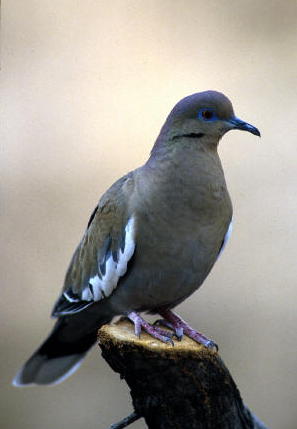

Introduction
Zenaida asiatica, more commonly known as the white winged dove, is a bird native to Southwestern USA, Mexico, Central America, and the Carribbean [1]. The dove is light gray in color and gets its name from a distinct bright white wing patch. These doves are migratory birds and can fly 15 miles for water and food [1]. They can feed on a variety of fruits, seeds, and grains but are highly dependent on the fruit and nectar of Carnegiea gigantea, also known as the Saguaro cactus. The Saguaro is a large cactus native to the Sonoran Desert in Arizona [3]. White flowering plants grow on the ends of cactus branches providing nectar and food for the dove while the dove pollinates the plant, thus resulting in a mutualistic relationship [4].
 Relationship
RelationshipMutualism is an ecological interaction in which two species both benefit from eachother. There are many types of mutualisms, such as dispersive mutualism. These are interactions in which one partner recives food or nutrients in exchange for moving the seeds or pollen of its mutualistic partner [6]. Since Saguaro reproduction occurs in the hottest and driest months of the year, the fruit of the cactus provides nutrients and moisture for the dove to survive during these temperatures [4]. The flowers of the large Saguaro become fruit and a new source of food for the doves. The fruit is filled with tiny seeds that, once taken up by the dove, pass through its digestive system without harm [5]. These seeds may be dropped in the feces of the dove, creating a new Saguaro plant several feet or miles away from the parent plant.
Cost and Benefit Analysis
For the white winged dove, there seems to be no cost. The cactus is very beneficial and provides the dove with much needed food and shelter during hot summer months. The dove builds a nest inside the cactus for a moist place to live in the otherwise dry desert. It also feeds on the nectar of the flowering plant obtaining food and nutrients [4]. The Saguaro cactus also seems to have no cost. The dove is beneficial to the Saguaro because it carries the cactus seeds within the nectar in its body until its feces are dropped far away from the parent cactus, thus pollinating the plant.

[1] http://en.wikipedia.org/wiki/White-winged_Dove
[2] http://www.discoverseaz.com/Wildlife/White-wingedDove.html
[3] http://www.discoverseaz.com/Wildlife/Saguaro.html
[4] http://www.desertmuseum.org/pollination/doves.php
[5] http://www.nps.gov/sagu/naturescience/white-winged-dove.htm
[6] http://www.buzzle.com/articles/examples-of-mutualism.html
Zenaida asiatica can feed on a variety of fruits, seeds, and grains but are highly dependent on the fruit and nectar of Carnegiea gigantea, also known as the Saguaro cactus. Can Carnegiea gigantea provide the same amount of nutrients to Zenaida asiatica when the season changes? Also, if the cactus somehow becomes parasitized (if possible) can it still produce flowers for the bird?
ReplyDeleteYou mentioned that the Zenaida asiatica lives inside of the cactus. Does this negatively affect the cactus, like by reducing the amount of water it can retain or limiting the space where flowers can bloom? Are there other means of pollination for the cactus or does it solely depend on the bird?
ReplyDeleteIs zenaida asiatica the only organism that benefits from the fruit of the cactus and use it for shelter, or does it have to compete with other types of birds for the benefits?
ReplyDeleteWEBSITE1
ReplyDeleteWEBSITE2
WEBSITE3
WEBSITE4
WEBSITE5